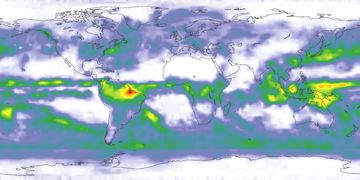
 |
||
|
|
||
| View other datasets |
|
|
| ||
 |
|||
| Coverage of this dataset spans January 1979 to April 2006. | |||
The animation features of the Earth Observatory are currently unavailable. We apologize for the inconvenience. To view the full temporal span of this dataset, please view the Precipitation monthly holdings. | |||
 Product description: Researchers estimate precipitation across the entire globe by considering many different kinds of input data. Rain gauges are the most accurate, but limited to populated land areas. A variety of satellites provide complete global coverage, but they present two major challenges: First, the various satellite sensors only observe quantities related to precipitation, and algorithms must be developed to get the best estimate from each particular sensor. Second, the mix of available data is constantly changing in space and time, forcing researchers to cope with the particular reliabilities and biases at each time/space grid box. The precipitation data set displayed in this loop is computed in the NASA/GSFC Laboratory for Atmospheres as a contribution to the GPCP, an international research project of the World Meteorological Organization's Global Energy and Water Exchange program. Detailed information and a variety of precipitation products and images are available at http://precip.gsfc.nasa.gov/ . This loop covers the continuous period of quantitatively useful satellite data, from January 1979 to the present (minus the last few months due to lags in processing). Outstanding features include the semi-permanent Intertropical Convergence Zone running near the Equator, Subtropical dry zones, and mid-latitude storm tracks. The seasonal North-South migration of major precipitation areas occurs in response to changes in solar heating. Strong El Nino events occur in the central Pacific in 1982-3 and 1997-8.
|
|
Subscribe to the Earth Observatory About the Earth Observatory Contact Us Privacy Policy and Important Notices Responsible NASA Official: Lorraine A. Remer Webmaster: Goran Halusa We're a part of the Science Mission Directorate |